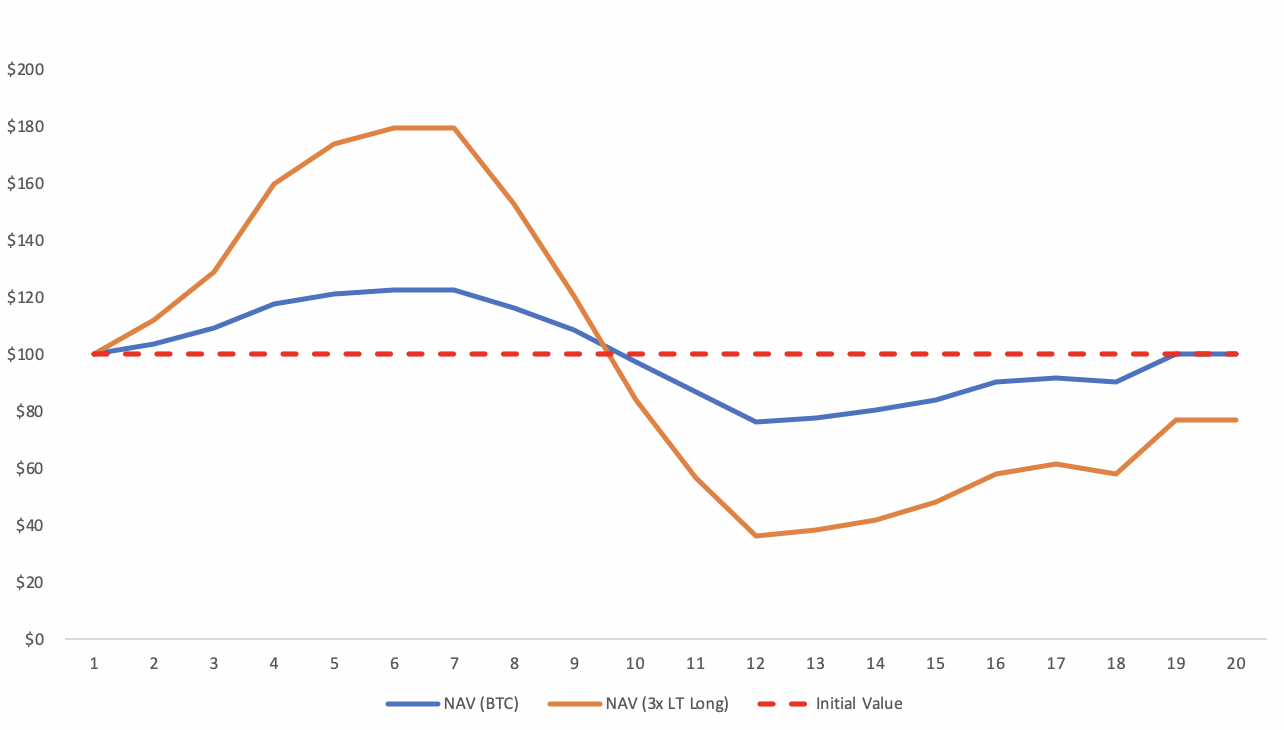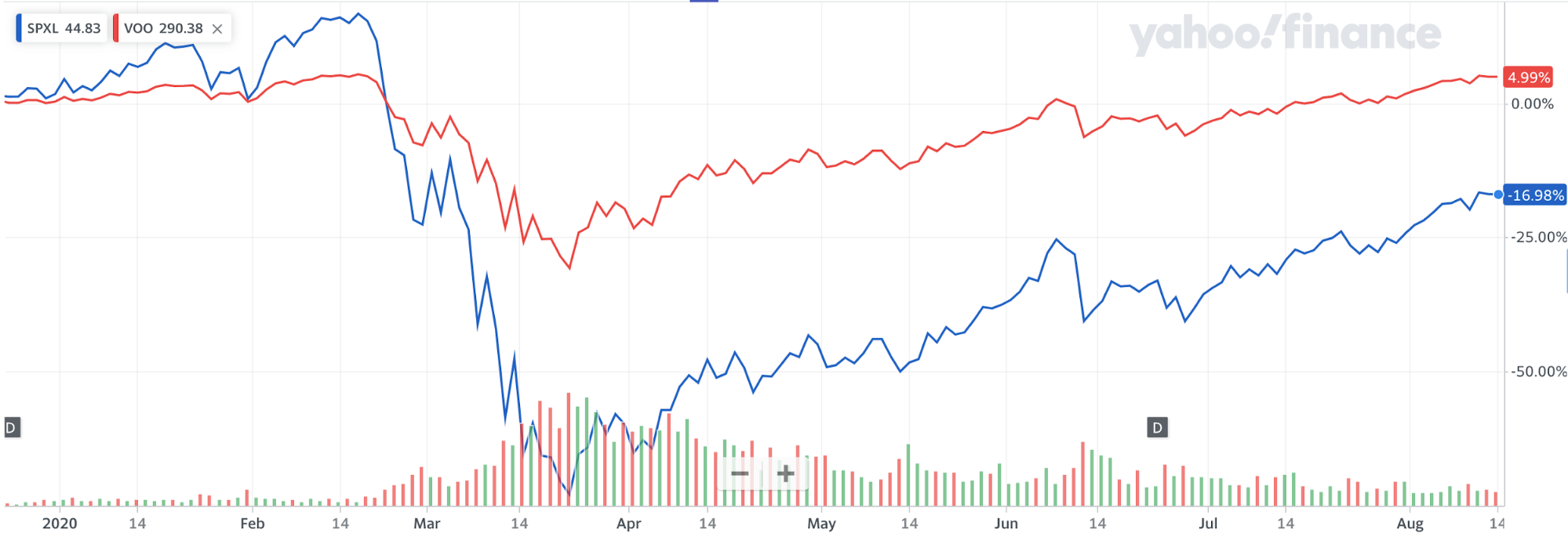Unlike conventional leveraged tokens, Binance Leveraged Tokens (BLVT) does not maintain ‘constant leverage’. Instead, BLVT offers variable leverage. The variable leverage mechanism provides many advantages, as explained in previous articles.
For more information:
Read: Your Essential Guide To Binance Leveraged Tokens
Read: Boosting Returns With Strategic Rebalancing
Despite its benefits, there are many risks that traders should keep in mind before trading leveraged tokens.
In this article, we will analyze four mistakes that you should avoid when trading leveraged tokens in order to protect capital and avoid excess risk.
1. Holding Leveraged Tokens for the long-term
One of the most common mistakes is holding leveraged tokens for extended periods.
Investing in leveraged tokens for the long-term may seem lucrative, given their ability to amplify investment returns. However, there are risks in doing so. Conventional leveraged tokens are rebalanced and re-leveraged every day, and most investors fail to recognize this impact.
Often, we receive questions regarding the performance gap of tokens and their underlying cryptocurrency. For instance, when the underlying cryptocurrency declined by 5% in the previous week, why didn’t the corresponding token return 15% in this period?
Depending on market movements and rebalancing, performance over time may vary.
In trending markets with low volatility, the performance for periods longer than a day may exceed the return of the underlying asset. However, in volatile markets, daily rebalancing is likely to harm the token’s long-term performance.
As such, the long-term performance of leveraged tokens is unpredictable because of how the compounding effect works differently.
With BLVT, tokens are rebalanced only in extremely volatile markets, as we have seen recently in several cryptocurrencies such as LINK and ETH. However, under normal market conditions, BLVT rebalances less than other leveraged tokens.
Despite the advantages of BLVT, users are not encouraged to hold tokens long-term as volatility has a significant impact on its performance. We will dive deep into the explanation in the following points.
2. Ignoring the impact of volatility decay
So, why does the performance of leveraged tokens vary from its underlying cryptocurrency?
The fundamental cause is volatility.
It is absolutely true that during trending periods you can have enhanced returns on your investment, which is the primary objective of leveraged tokens. However, when the underlying cryptocurrency declines in value or has higher volatility, the likely result will be compounding losses.
Leveraged tokens are designed to amplify the daily movements of an underlying cryptocurrency. Thus, this also means that volatility is amplified by a constant leverage factor.
In the following example, we explain how volatility risk impacts the value of leveraged tokens. In this scenario, we compare the daily returns of BTC vs a conventional 3x LT BTCUP over 20 trading days.
BTC
3x LT Long
Day
Daily return
NAV
Daily return
NAV
1
0%
$100
0%
$100
2
4%
$104
12%
$112
3
5%
$109
15%
$129
4
8%
$118
24%
$160
5
3%
$121
9%
$174
6
1%
$123
3%
$179
7
0%
$123
0%
$179
8
-5%
$117
-15%
$152
9
-7%
$108
-21%
$120
10
-10%
$98
-30%
$84
11
-11%
$87
-33%
$56
12
-12%
$76
-36%
$36
13
2%
$78
6%
$38
14
3%
$80
9%
$42
15
5%
$84
15%
$48
16
7%
$90
21%
$58
17
2%
$92
6%
$62
18
-2%
$90
-6%
$58
19
11%
$100
33%
$77
20
0%
$100
0%
$77
Chart 1 - Performance of Bitcoin vs. 3x LT Long (Bitcoin in Blue, LT in Orange)

In the above example, we simulated three different market phases. The first phase was a simulated rally, where daily price movements were under 10%. In this phase, Bitcoin’s value rose from $100 to $123. Subsequently, the price trend reversed and transited downwards with larger volatility ranging from -5% to -12%. As a result, Bitcoin’s value declined from $123 to $76. The final phase was a market recovery where Bitcoin’s value eventually recovered back to its initial price of $100 after bottoming at $76. As shown, Bitcoin ended unchanged despite an extremely volatile performance over the 20 trading days.
On the other hand, the 3x LT ended 23% lower from its initial value despite following the same price trend in Bitcoin. Although many would expect the 3x LT to recover, this was not the case due to periods of high volatility that resulted in an effect known as ‘volatility decay’. Volatility decay is the long-term, detrimental impact that volatility has on the investment. The higher the volatility and the longer the time horizon, the more harmful the effect of volatility decay.
This situation here is not only prevalent in cryptocurrency leveraged tokens. We observed the same phenomenon in traditional markets, such as the leveraged ETFs that mirror the S&P 500.
Chart 2 - Performance of the S&P 500 vs. Leveraged ETF (Year-To-Date)

The graph above compares an S&P 500 ETF (VOO) vs. a 3x BULL leveraged ETF (SPXL) that tracks the daily performance of the S&P 500. Analyzing both securities’ performance, we observed that the leveraged ETF outperformed the index between January to February. As the index plunged amid the COVID-19 crisis, the leveraged ETF plummeted harder because of its mandate to amplify daily performance by a factor of 3. This resulted in compounding losses for investors who bought the leveraged ETF in this period.
Since April, S&P 500 has recovered from the crash and is currently positive YTD. Meanwhile, the leveraged ETF is still deep into negative territory, currently down 16.9% YTD.
This example shows the sheer destructive nature of leveraged tokens. It also shows the impact high-volatility has on leveraged products and explains why leveraged tokens might not necessarily follow the long-term performance of its underlying cryptocurrency.
Although BLVT is designed to reduce the impact of volatility decay by maintaining variable target leverage, in extremely volatile markets as we have seen lately, investors must mitigate the risk and avoid holding BLVT for the long-term.
3. Ignoring the impact of regular rebalancing
Due to its daily leverage mandate, leveraged tokens are rebalanced by reducing or increasing their exposure to the underlying cryptocurrency. The following example shows how rebalancing works.
Assume a 3x LT with an initial Net Asset Value (NAV) of $100 million. In line with its mandate, the LT maintains a total exposure of $300 million in the underlying cryptocurrency.
Day
Daily return
NAV (in millions)
Exposure (in millions)
Net Difference
T+0
$100
$300
T+1
5%
$105
300 x (1 + ((0.05 x 3) / 1) ) = $345
$+45
T+2
(-3%)
$101.85
345 x (1 + ((-0.03 x 3) / 1)) = $313.95
$-31.05
As shown, the fund will increase its exposure as the underlying cryptocurrency increases in value. Likewise, the exposure will be reduced as the value of its underlying cryptocurrency declines.
As a result of regular rebalancing, investors holding a leveraged token longer than a day could see their exposure levels rise or fall dramatically. Therefore, affecting their original investment.
Therefore when the market is highly volatile, it triggers more rebalancing events, thereby, causing a performance diversion between the token and its underlying cryptocurrency.
4. Letting losers run
This is a classic mistake. Novice traders tend to fall in love with losers and never get out.
Novice traders look for excuses on why the market is wrong and hold onto losers in hopes that the market will eventually turn in their favor. Remember that the market is always right!
As shown in earlier examples, the long-term performance of a leveraged token may vary from the underlying spot market.Even if you have correctly predicted the price movement of the underlying cryptocurrency, the long-term performance of leveraged tokens are unpredictable because of the daily volatility of the market.
The more volatile the underlying asset is, the more token value will lose over time, even if the underlying cryptocurrency closes flat at the end of the year. If the underlying cryptocurrency moved up and down drastically along the way, you might lose a significant percentage of the token value if you bought and held it.
Final Thoughts
Leveraged tokens are easy to use but hide considerable complexity. Behind the scenes, the fund constantly rebalances to maintain a target leverage exposure. This results in additional expenses and significant fluctuations in index exposure.
As such, it is unlikely for leveraged tokens to provide amplified returns of the index for long periods. In general, leveraged tokens are not the substitute for holding assets in the spot market, and that applies to BLVT as well.
However, if traders predict market moves correctly, they will generally make money by trading BLVTs. It offers many viable alternatives for amplifying gains, putting less trading capital at risk, and profiting with strong market momentum.


